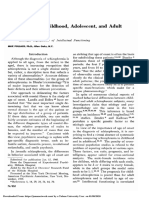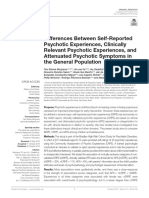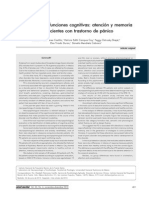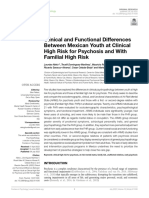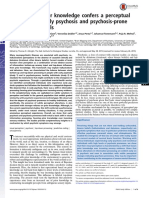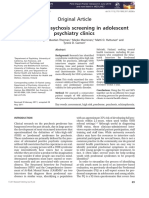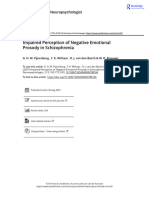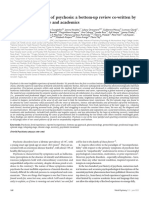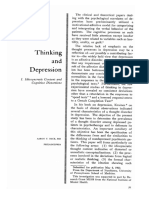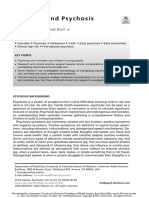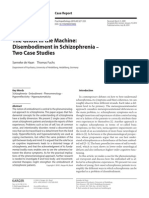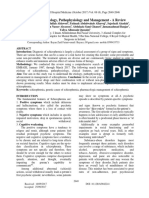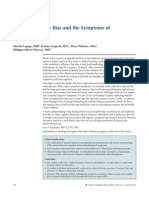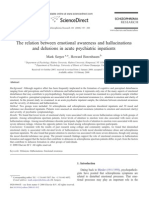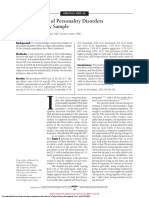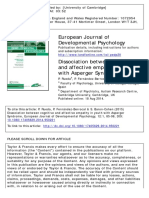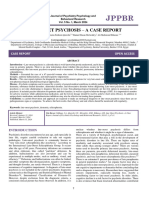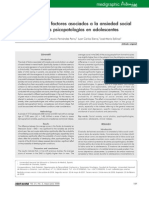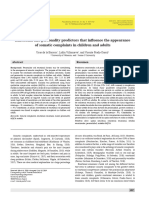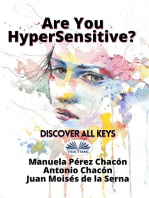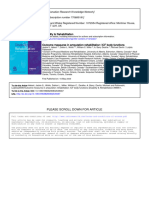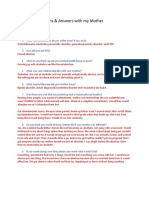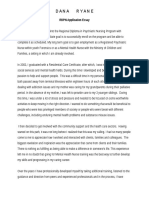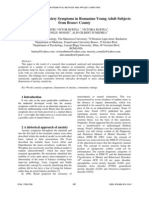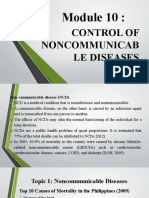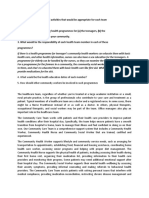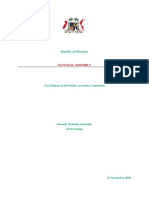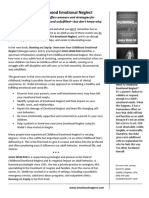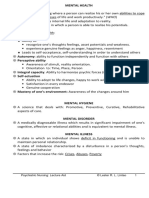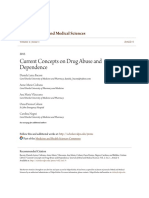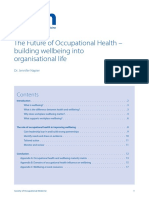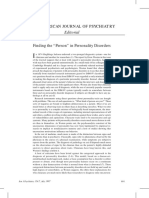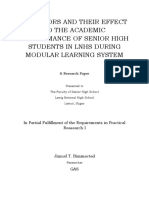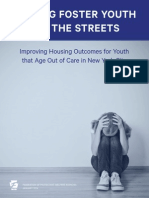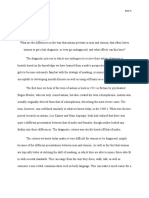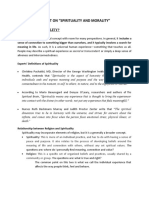Esquizoq Articulo3
Esquizoq Articulo3
Uploaded by
juanpaulomunera2Copyright:
Available Formats
Esquizoq Articulo3
Esquizoq Articulo3
Uploaded by
juanpaulomunera2Original Title
Copyright
Available Formats
Share this document
Did you find this document useful?
Is this content inappropriate?
Copyright:
Available Formats
Esquizoq Articulo3
Esquizoq Articulo3
Uploaded by
juanpaulomunera2Copyright:
Available Formats
Original
Eduardo Fonseca-Pedrero1
Marta Santarén-Rosell1
Psychotic-like experiences in the
Serafín Lemos-Giráldez1 adolescent general population
Mercedes Paino1
Susana Sierra-Baigrie1
José Muñiz1
1
Psychology Department
Universidad de Oviedo
Centro de Investigación Biomédica en Red de Salud Mental
CIBERSAM
Objective. The main purpose of this study was to analyze nuados en población adolescente no clínica. Asímismo,
the distribution of psychotic-like experiences in nonclinical se profundizó en el papel que desempeñan el sexo y la
adolescents. Likewise, we studied in depth the role of gender edad en la expresión fenotípica de dichas experiencias.
and age in phenotypal expression of these symptoms.
Método. En el estudio participaron un total de 1.438
Method. A total of 1438 adolescents entered the study, 691 adolescentes, 691 (48,1 %) varones, con una edad media
(48.1%) were men, with a mean age of 15.9 years (SD = 1.2). de 15,9 años (DT = 1,2).
Results. The results indicated that attenuated psychotic Resultados. Los resultados mostraron que los sínto-
symptoms are a very common phenomenon in this age mas psicóticos subclínicos son un fenómeno bastante co-
group, since 43% of the sample reported symptoms belonging mún dentro de este grupo de edad. El 43% de la muestra
to magical thinking, ideas of reference, and/or delusion or informó de algún síntoma relacionado con el pensamien-
hallucination experiences, and 8.9% reported 4 or more to mágico, la ideación referencial y/o las experiencias
psychotic-like experiences. Statistical significant differences delirantes o alucinatorias. El 8,9% refirió 4 o más expe-
were found in ideas of reference and paranoid ideation riencias psicóticas subclínicas. Se encontraron diferen-
cias estadísticamente significativas en función del sexo
between genders, but not among age groups.
en ideación referencial e ideación paranoide, en cambio
no se hallaron diferencias estadísticamente significativas
Conclusion. Our results coincide with those found in
en función de la edad.
previous studies and have clear implications for a better
understanding of these psychological phenomena in the
Conclusión. Estos resultados son convergentes con los
framework of developmental psychopathology, and for the
datos encontrados en la literatura previa y tienen claras
implementation of early detection and prevention programs implicaciones de cara a la comprensión de este fenómeno
in the population sector. psicológico dentro de los modelos de psicopatología del
Keywords:
desarrollo, así como en lo relativo al establecimiento de
Schizotypy, Psychosis, Subclinical Symptoms, Adolescents, Psychotic-like experiences, Risk. programas de prevención y detección temprana en este
sector de la población.
Actas Esp Psiquiatr 2011;39(3):155-62
Palabras clave:
Esquizotipia, Psicosis, Síntomas Subclínicos, Adolescentes, Experiencias psicóticas,
Riesgo.
Síntomas psicóticos subclínicos en población
general adolescente
Objetivo. El principal propósito de este trabajo fue
analizar la distribución de los síntomas psicóticos ate- INTRODUCTION
Correspondence: Psychotic symptoms, such as hallucinatory experiences,
Eduardo Fonseca-Pedrero
Facultad de Psicología magic thinking or delusional symptoms are a very common
Plaza Feijoo, s/n, Oviedo
C.P: 33003, Spain.
and psychological phenomenon among the general
Tel.: +34-985-10-32-72 population.1-3 This combination of experiences, known as
Fax: +34-985-10-41-44
E-mail: efonseca@cop.es pseudo-psychotic or subclinical psychotic symptoms occurs
13 Actas Esp Psiquiatr 2011;39(3):155-62 155
Eduardo Fonseca-Pedrero, et al. Psychotic-like experiences in the adolescent general population
below the clinical threshold or is not necessarily associated (ESQUIZO-Q)22 (Oviedo Questionnaire for the Evaluation of
with a psychopathological, medical disorder or disorder of Schizotypy) in a sample of 1653 adolescents, found that from
another type.3 Within the dimensional models of psychosis, 2.7% to 17.4% of the participants reported some type of
it is considered that the psychotic phenotype is distributed subclinical experience. In this same work, in a sample of 4868
along a severity continuum, the clinical picture being located nonclinical adolescents, they analyzed two items from the
in most extensive part. In this sense, pseudo-psychotic Youth Self Report (YSR)23 that evaluated auditory and visual
symptoms could be considered as an “intermediate” variant hallucinatory phenomena. The results indicated that
or phenotype that is quantitatively less severe but approximately 11-12% of the sample contested affirming at
qualitatively similar to the symptoms seen in patients with least one item and that 5.2% stated they had experienced
schizophrenia, these occurring with less intensity, persistence, some hallucinatory phenomena.
frequency and associated discapacity.4-7
As occurs with schizophrenia, the phenotypal expression
Independent longitudinal studies performed in samples of these experiences on the subclinical level seems to vary
of the general population show that the presence of these based on gender and age.1, 2, 24, 25 Based on gender, adult
psychotiform signs at early ages increases the future risk of women generally report a greater number of positive
developing a disorder on the schizophrenic spectrum,8-11 and psychotic symptoms compared to adult males.24 In the same
also predicts the delusional experiences in the adult stage.12 way, adolescent women generally have more subclinical
For example, Poulton et al.,9 in a longitudinal study carried psychotic symptoms than the males.26, 27 However, both in
out in New Zealand in a sample of children, found that more the adult population28, 29 as well as in the adolescent one,
than 25% of the participants who reported these experiences results that do not indicate this association have been
at the age of 11 years developed a disorder of schizophreniform found.17, 19, 30 In relationship with age, younger participants
type at the age of 26 years. In the same way, as the temporal generally have higher scores in attenuated psychotic
persistence and frequency of these subclinical psychotic symptoms in comparison with older subjects,3, 27, 31 although
symptoms increase, the probability of evolving towards a works that only compare adolescent groups have not
clinical picture also increases.5, 13 The predictive value of confirmed these findings,17, 30 or have even found results to
these experiences is not only restricted to the studies the contrary.26
conducted in samples of the general population but also in
high-risk samples. In this sense, the presence of these Up to now in Spain, few empirical works have been
symptoms plays an important role in the subsequent carried out that attempt to analyze and understand the
transition towards disorders on the schizophrenic spectrum, phenotypal expression of subclinical psychotic symptoms in
both in first-degree family members of patients with the adolescent population. On the other hand, the role of
schizophrenia14 as well as in individuals with high clinical gender and age in the expression of these symptoms has also
risk.15, 16 These data suggest that attenuated psychotic not been clearly defined. Within this context of research, the
experiences could be considered as the behavioral expression principal objective of the present work was to examine the
of vulnerability to schizophrenic psychosis and its related presence of attenuated psychotic symptoms in a
disorders (e.g. schizoid, paranoid and schizotypal personality representative sample of adolescents from the general
disorders). population. Furthermore, the role played by gender and age
in the phenotypal expression of this type of pseudo-psychotic
Epidemiological studies conducted in the adult population experiences was also studied in greater depth. These
situated the mean prevalence of subclinical psychotic objectives are interesting since they make it possible to: a)
experiences at about 5%.3 In the adolescent population, improve the understanding of the attenuated psychotic
similar rates as those found in the adult population are found. symptoms, as markers of risk or vulnerability for
For example, Scott et al.,17 analyzing a sample of 1261 schizophrenia, without the compounding effects frequently
Australian adolescents, found that 8.4% of them reported found in patients (e.g. medication and stigmatization) and
having experienced some visual or auditory hallucinatory before the clinical expression of the disorder; b) the early
experience at some time. On his part, Horwood et al.,18 using a detection of individuals at risk for disorders on the
sample of 6455 English adolescents, found that 38.9% scored schizophrenic spectrum and the establishment of action
on more than one item regarding psychotic experiences. In lines within the early intervention programs in a period of
Spain, the interest in subclinical psychotic symptoms studies special risk for the development of the psychopathological
in the adolescent population has also increased. For example, picture as in adolescence; c) have empirical data available in
Obiols et al.,19 using the Community Assessment of Psychic the general Spanish population that can be used within the
Experiences (CAPE)20 in a sample of 777 adolescents, found psychoeducational programs (e.g., patients with schizophrenia
that 44.1% reported at least one quasi-psychotic symptom or at high clinical risk) in order to demystify the presence of
and 19.7% manifested 3 or more experiences of this type. On these symptoms only within the psychotic picture and d) go
his part, Fonseca-Pedrero et al.,21 using 10 items from the deeper into the dimensional models of psychoses within the
Cuestionario Oviedo para la Evaluación de la Esquizotipia paradigm of the psychopathology of development.
156 Actas Esp Psiquiatr 2011;39(3):155-62 14
Eduardo Fonseca-Pedrero, et al. Psychotic-like experiences in the adolescent general population
METHOD Interpersonal Disorganization. The construction and
validation of the ESQUIZO-Q were performed in a sample of
Participants 1653 non-clinical adolescents, and had adequate
psychometric properties. The internal consistency levels for
the subscales ranged from 0.62 to 0.90, and different
The selection of the participants was made using random
evidences of validity were obtained with other self-reports
stratified sampling by clusters in the classroom in a
that evaluated emotional and behavioral symptoms.22, 37 For
population of approximately 36,000 students belonging to
the present study, only 21 items belonging to the dimension
the regional community of the principality of Asturias. The
of Reality Distortion were used. This includes the subscales:
strata were created based on geographic zone (East, West,
Ideas of Reference, Magical Thinking, Unusual Perceptual
Central and Mining Zone) and the school period (obligatory
Experiences and Paranoid Ideation. The items corresponding
and post-obligatory). The likelihood of choice of each center
to the dimension Reality Distortion of the ESQUIZO-Q are
was directly proportional to the number of students
presented in the Annex.
corresponding to it. The students belonged to different
public, charter and private school centers of Obligatory
Escala Oviedo de Infrecuencia de Respuesta (INF-OV)30
Secondary Education (ESO) and Vocational Training Cycles.
is a self-report made up of 12 items with Likert type format
The initial sample was made up of 1628 students, although
having 5 categories (1 “totally disagree” and 5 “totally
the following participants were eliminated: those having a)
agree”) that has also developed following the guidelines for
more than 2 points on the Escala Oviedo de Infrecuencia de
the construction of tests35, 38 and multiple choice items.36 Its
Respuesta (Oviedo Scale of Infrequency of Response) (n =
purpose has been to detect those participants who have
64); b) learning difficulties (n = 6), c) age over 18 years (n =
responded randomly, pseudo-randomly or dishonestly in
35); d) omission of demographic data or elevated percentage
self-report measurements (e.g. “The distance between
of items that are unanswered (n = 49); and e) outliers scores
Madrid and Barcelona is greater than between Madrid and
(n = 36). In this way, the final sample was made up of a total
New York”). This type of self-report is frequently used in
of 1438 students, 691 males (48.1%) and 747 (51.9%)
studies on tendency to psychosis24 and makes it possible to
females, belonging to 28 schools centers and 90 classrooms.
obtain greater evidence of validity. The individuals who
The mean age was 15.92 years (SD = 1.17), age ranging from
score more than two items incorrectly were removed from
14 to 18 years. Distribution based on age for the sample was
participation in the research.
the following: 14 years (n = 191; 13.3%), 15 years (n = 349;
24.3%), 16 (n = 409; 28.4%) years, 17 years (n = 355; 24.7%)
and 18 years (n = 134; 9.3%).
Procedure
The questionnaires were administered collectively, with
Measurement instruments
groups of 10 to 35 students, during class hours and in a
room prepared for this purpose. The study was presented to
The Cuestionario Oviedo para la Evaluación de la the participants as an investigation on the different
Esquizotipia (ESQUIZO-Q)22 is a self report developed for the characteristics of the personality, assuring them that their
evaluation of schizotypal traits in the Spanish adolescent responses would be confidential and about the voluntary
population that can also be used for epidemiological character of their participation. In those cases in which it
purposes.21 It is based on the diagnostic criteria proposed in was considered to be appropriate, consent was requested
the DSM-IV-TR32 and in the Meehl schizotaxia model33 on from the parents of those participants under 18 years.
genetic predisposition to schizophrenia. The items of the Administration of the questionnaire was always performed
ESQUIZO-Q were selected based on an extensive review of under the supervision of an investigator. This study is
the literature on schizotypia and related constructs34. Its included within a more extensive investigation on the early
construction was performed according to the steps proposed detection and intervention in disorders of the schizophrenic
for the elaboration of tests35 and the guidelines for spectrum.
construction of multiple-choice items.36 Its response format
is 5-category Likert type with 1 being “completely disagree”
and 5 “completely agree.” The ESQUIZO-Q is made up of a
RESULTS
total of 10 subscales in Paraguay derived using factorial
techniques: Ideas of Reference, Magical Thinking, Unusual
Perceptual Experiences, Strange Thoughts and Language, Prevalence of the attenuated psychotic symptoms
Paranoid Ideation, Physical Anhedonia, Social Anhedonia, in the total sample
Odd Behavior, Lack of Close Friends and Social Anxiety. These
subscales are grouped into three general second order In table 1, the data related with the mean and standard
dimensions: Reality Distortion (Positive), Negative and deviation of the subscales and total score on the Reality
15 Actas Esp Psiquiatr 2011;39(3):155-62 157
Eduardo Fonseca-Pedrero, et al. Psychotic-like experiences in the adolescent general population
Table 1 Descriptive statistics than number of items answered positively by the participants
for the total score and the subscales selected from the ESQUIZO-Q
They scored affirmatively*
Subscales Total Men Women 1 ítem 2 ítems 3 or more items
M (SD) M (SD) M (SD) n (%) n (%) n (%)
Ideas of Reference 5.93 (2.5) 6.13 (2.7) 5.70 (2.3) 139 (9.7) 41 (2.9) 10 (0.7)
Magical Thinking 7.31 (2.8) 7.10 (2.7) 7.40 (2.9) 194 (13.5) 49 (3.4) 13 (0.9)
Perceptual Experiences 9.83 (3.8) 9.96 (3.9) 9.72 (3.8) 221 (15.4) 76 (5.3) 21 (1.5)
Paranoid Ideation 7.72 (3.2) 7.94 (3.3) 7.46 (3.1) 166 (11.5) 55 (3.8) 50 (3.4)
Total Score 60.80 (9.5) 31.13 (9.8) 30.28 (9.3) 268 (18.6) 134 (9.3) 216 (15)
* It is considered that an item has been answered positively when scored 4 or 5 in the response options of the questionnaire
Distortion dimension of the ESQUIZO-Q are presented, Analysis of Variance (MANOVA) was performed, using gender
both in the total sample and separately for the men and and age as fixed factors and the subscales and total score of
women. Furthermore, the number of participants who the positive dimension of the ESQUIZO-Q as dependent
reported one, two or three or more pseudo-psychotic variables. Wilk’s λ value showed statistically significant
experiences in the total sample was collected. It was differences based on gender (Wilk’s λ = 0.978, p < 0.001),
considered that an adolescent responded positively to an but not based on age (Wilk’s λ = 0.992, p = 0.802). Males
item on the ESQUIZO-Q when he/she chose their 4 or 5 scores higher than women on the Ideas of Reference
response options. As can be observed, a considerable subscales (F = 8.535, p = 0.004) and Paranoid Ideation (F =
percentage of the participants, that is 43%, reported some 6.984, p = 0.004). In both cases, the estimations of size of
type of subclinical psychotic experience. Breaking this effect were irrelevant. No statistically significant interactions
percentage down, 18.6% of the adolescents responded were found between gender and age of the participants.
positively to one item, 9.3% to two, 6.1% to three and (Tables 2 and 3).
8.9% to more than four items. The number and percentage
of participants of the total sample who responded
affirmatively to each one of the 21 items on the ESQUIZO-Q DISCUSSION AND CONCLUSIONS
are shown in Table 2. As can be observed, from 1.9% to
8.4% of the adolescents manifested symptoms related with The principal objective of this work was to analyze the
ideas of reference (items 1 to 4); from 1.5 % to 6.7% prevalence of the attenuated psychotic symptoms in the
reported experiences related with magical thinking (items general adolescent population and examine the role played
5 to 9); from 1.5% to 11.5% manifested symptoms related by gender and age in the phenotypal expression of these
with paranoid ideation (items 10 to 14) and finally from experiences. The results indicate that 43% of the participants
1% to 8.8% of the adolescents reported symptoms related reported positively having experienced at least one
with unusual perceptual experiences (items 15 to 21). The attenuated psychotic symptom. The rates of subclinical
items that obtained a higher rate of affirmative responses experiences found in this work are slightly superior to those
were item 11 (Someone has sworn to get me) and item 19 found in previous investigations in community samples of
(I have such real thoughts that it seems as if someone is the general population,1-3 and quite similar to those found in
talking to me). The items that obtained a lower rate of other studies performed in nonclinical adolescents.17, 19, 21, 39
affirmative responses were item 18 (I feel as if someone However, it should be mentioned that rigorous comparison
was sending occult messages that only I could understand) with other investigations was hindered because of the
and item 9 (When something goes wrong for me it is characteristics of the sample and measurement instrument
because someone has put a curse on me). (Table 1). as well as by the definition per se of the concept “Attenuated
psychotic symptoms” or “subclinical” symptoms. For example,
recently van Os et al.3 conducted a meta-analysis, finding
Expression of attenuated psychotic symptoms that the mean rate of these experiences in the adult
based on gender and age population was approximately 5%. However, in studies with
adolescent populations, slightly different percentages were
After, the relationship of gender and age with subclinical found, ranging from 2.2% to 73.1%.21 Specifically, previous
psychotic symptoms was studied. To do so, a Multivariate works performed in Spain have found similar results to those
158 Actas Esp Psiquiatr 2011;39(3):155-62 16
Eduardo Fonseca-Pedrero, et al. Psychotic-like experiences in the adolescent general population
statistically significant differences were found based on age.
Table 2 Percentage of participants of the total The results found based on gender are partially contrary to
sample and men and women separa- those found in the previous literature, although it is also
tely who scored 4 or 5 on the items true that the mean scores are almost identical and the sizes
selected from the ESQUIZO-Q of effect were insignificant. Previous studies found that
adolescent women generally have more subclinical psychotic
Item Total (n =1438) Men (n = 691) Women (n = 747) symptoms then men,26, 27 although there are some studies
n (%) n (%) n (%) that did not find this association17, 19, 30 in the adult
population28, 29 and adolescent population. In regards to the
1 54 (3.8) 30 (4.3) 24 (3.2) age variable, and consistent with the previous literature,
2 121 (8.4) 64 (9.3) 97 (7.6) both in the general adults as well as adolescent population,
3 48 (3.3) 36 (5.2) 12 (1.6) no significant association was found regarding the symptoms
evaluated with age.17, 30 However, as occurred with gender,
4 28 (1.9) 16 (2.3) 12 (1.6)
other works have found such an association.1, 27, 31 This
5 52 (3.6) 26 (3.8) 26 (3.5) variability in the results stresses the need to continuing
6 96 (6.7) 50 (7.2) 46 (6.2) studying and to go deeper into depth regarding the role
7 68 (4.7) 26 (3.8) 42 (5.6) played by gender and age in the phenotypal expression of
8 94 (6.5) 40 (5.8) 54 (7.2)
this symptomatology.
9 21 (1.5) 7 (1.0) 14 (1.9)
Adolescence is a period of development in which
10 83 (5.8) 50 (7.2) 33 (4.4) attenuated psychotic symptoms such as magical thinking,
11 165 (11.5) 91 (13.2) 74 (9.9) paranoid thinking or hallucinatory experiences may occur
12 38 (2.6) 17 (2.5) 21 (2.8) with much frequency, similar to those found in patients with
schizophrenia, although with a milder pattern of severity,
13 40 (2.8) 20 (2.9) 20 (9.2)
lower persistence, intensity, associated discomfort and not
14 21 (1.5) 11 (1.6) 10 (1.3) invariably linked to a psychopathological disorder.4-7
15 86 (6.0) 40 (5.8) 46 (6.2) Specifically, these experiences are maintained persistently
16 26 (1.8) 17 (2.5) 9 (1.2) and evolve unfavorably and reach clinical expression causing
a clinically significant impact only in a reduced group of
17 38 (2.6) 16 (2.3) 22 ( 2.9)
adolescents.5, 10 The temporal persistence of this phenomenon
18 14 (1.0) 12 (1.7) 2 ( 0.3) during the adult and adolescent stages occurs in
19 126 (8.8) 60 (8.7) 66 (8.8) approximately 10-35%.3, 40 Logically, these experiences
20 123 (8.6) 60 (8.7) 63 (8.4) should interact synergically or additively with other
environmental risk factors (e.g. first-degree relatives with a
21 125 (8.7) 63 (9.1) 62 (8.3)
psychotic disorder) and/or psychological (e.g. depressive
symptoms) for this to result in a clinical case.41 The possible
evolutional pathways towards psychotic disorders may be
heterogeneous and diverse and the mere presence of them
found in the present study in regards to percentages, such as
does not presuppose a severe psychopathological disorder in
the work of Obiols et al.19 who found that 44.1% of the
a near future.
adolescents reported having experienced some pseudo-
psychotic symptom. On the contrary, Fonseca-Pedrero et The results found in the present study should be
al.21 found some slightly lower psychotiform experience interpreted considering the following limitations. In the first
rates, with positive responses since some item between 2.7% place, age is a significant factor to consider in the
and 17.4% of the participants. These results indicate that phenomenological expression of these symptoms.
the psychotic symptoms expand beyond the frontiers Adolescence is a maturation period of development in which
proposed by the international classification symptoms (e.g. there are a series of changes on different levels (biological,
DSM-IV-TR), supporting the continuity of the psychotic affective, cognitive and social) that could be playing an
phenotype in the population and therefore the dimensional important role in the results of the study. In the second
models of psychosis. place, there are the problems inherent to the application of
any type of self-report, with the possible difficulties in the
Regarding the second purpose of this study, the study interpretation and understanding of some of the items by
of the role of gender and age in the phenotypal expression the participants as well as the possibility of elevated rates of
of these symptoms indicated that men obtained a mean false positives. Therefore, it would have been interesting to
higher score than women on the Ideas of Reference and have used external informers, such as the parents or
Paranoid Ideation subscales. On the other hand, no professors, via hetero-reports. In the third place, the cross-
17 Actas Esp Psiquiatr 2011;39(3):155-62 159
Eduardo Fonseca-Pedrero, et al. Psychotic-like experiences in the adolescent general population
Table 3 Percentage of participants, based on age, who scored 4 or 5 on the items selected
from the ESQUIZO-Q
Items 14 years 15 years 16 years 17 years 18 years
(n=191) (n=349) (n=409) (n=355) (n=134)
n (%) n (%) n (%) n (%) n (%)
1 5 (2.6) 18 (5.2) 16 (3.9) 14 (3.9) 1 (0.7)
2 12 (6.3) 27 (7.7) 34 (8.3) 35 (9.9) 13 (9.7)
3 2 (1.0) 13 (3.7) 22 (5.4) 7 (2.0) 4 (3.0)
4 6 (3.1) 5 (1.4) 5 (1.2) 7 (2.0) 5 (3.7)
5 5 (2.6) 12 (3.4) 14 (3.4) 13 (3.7) 8 (6.0)
6 11 (5.8) 23 (6.6) 36 (8.8) 22 (6.2) 4 (3.0)
7 9 (4.7) 17 (4.9) 22 (5.4) 15 (4.2) 5 (3.7)
8 9 (4.7) 23 (6.6) 22 (5.4) 30 (8.5) 10 (7.5)
9 3 (1.6) 6 (1.7) 8 (2.0) 3 (0.8) 1 (0.7)
10 13 (6.8) 22 (6.3) 28 (6.8) 11 (3.1) 9 (6.7)
11 19 (9.9) 40 (11.5) 51 (12.5) 39 (11) 16 (11.4)
12 7 (3.7) 8 (2.3) 10 (2.4) 8 (2.3) 5 (3.7)
13 2 (1.0) 9 (2.6) 13 (3.2) 11 (3.1) 5 (3.7)
14 3 (1.6) 4 (1.1) 9 (2.2) 3 (0.8) 2 (51)
15 9 (4.7) 27 (7.7) 19 (4.6) 22 (6.2) 9 (6.7)
16 2 (1.0) 8 (2.3) 8 (2.0) 7 (2.0) 1 (0.7)
17 5 (2.6) 14 (4.0) 6 (1.5) 11 (3.1) 2 (1.5)
18 2 (1.0) 3 (0.9) 2 (0.5) 4 (1.1) 3 (2.2)
19 17 (8.9) 31 (8.9) 35 (8.6) 30 (8.5) 13 (9.7)
20 18 (9.4) 22 (6.3) 32 (7.8) 33 (9.3) 18 (13.7)
21 12 (6.3) 28 (8.0) 43 (10.5) 77 (7.6) 15 (11.2)
sectional nature of this research must not be overlooked, so relationship between these psychotiform experiences with
that it is not possible to establish cause -effect interferences. other biochemical, physiological, environmental, behavioral
In the fourth place, and no less important, these psychotic and psychosocial variables in order to predict the possible
experiences should always be understood and analyzed clinical picture. Finally, the development of programs for
within a bio-psychosocial model in which the interaction early detection and intervention within the national public
and combination of a wide diversity of variables are and private health systems is of great importance. These
considered. In this sense, as already mentioned, in order to should have the basic and priority objective of early
develop a severe mental disorder, the combination of prevention of schizophrenia and its related disorders, in
multiple factors (genetic, environmental, etc.) and the order to mitigate the possible impact that may be caused on
necessary presence of other psychopathological signs and the personal, familial and social level by this devastating
symptoms (social withdrawal, flattened affectivity, thinking psychological disorder.
problems, odd behavior, significant alteration of the social
and work life, etc.) is necessary.
ACKNOWLEDGMENTS
Future lines of investigation should continue to study
the role of subclinical psychotic symptoms in the prediction This investigation has been financed by the Ministerio
of schizophrenic spectrum disorders both in the general de Ciencia e Innovación de España (MICINN), by the Instituto
population and in the participants at risk and through the Carlos III, Centro de Investigación Biomédica en Red de Salud
combined use of different measurement instruments.42-44 Mental (CIBERSAM). References of the projects: BES 2006-
Furthermore, it is also interesting to determine the type of 12797, PSI 2008-06220 and PSI 2008-03934.
160 Actas Esp Psiquiatr 2011;39(3):155-62 18
Eduardo Fonseca-Pedrero, et al. Psychotic-like experiences in the adolescent general population
Annex Items and subscales making up the Positive dimension of the ESQUIZO-Q
1. I believe that what appears on the radio or television has a special significance for me, that my friends do not understand
2. I notice that certain things have a hidden significance that only I can understand
3. I believe that I can detect hidden messages on the television or radio
4. I have the rare sensation that the things that appear on the radio or television are especially aimed to me
5. My lucky charms can even make me pass an examination
6. I believe that there are people who can read the minds of others
7. The dreams I have are signs that something bad is going to occur
8. I believe that there are persons who can control the thoughts of others
9. When something goes wrong for me, it is because someone has put a curse on me
10. I believe that someone is plotting against me.
11. Someone has sworn to get me
12. People look at me with disdain
13. The others think I am a bad person
14. My classmates have it in for me
15. When I am alone at home, I have the sensation that someone is speaking to me
16. I hear voices that others cannot hear
17. When I am alone, I have the sensation that someone is whispering my name
18. I feel as if someone sends occult messages that only I can understand)
19. I have such real thoughts that it seems as if someone is talking to me
20. I have felt like my body was not under my control
21. I have heard sounds that I cannot distinguish whether they are coming from my head or from outside
Items from 1 to 4 indicate Ideas of Reference
Items from 5 to 9 indicate Magical Thinking
Items from 10 to 14 indicate Paranoid Ideation
Items from 15 to 21 indicate Unusual Perceptual Experiences
REFERENCES An 8-Year Cohort Study. Schizophr Bull (in press).
6. Fonseca-Pedrero E, Paino M, Lemos-Giráldez S, Villazón-
1. Scott J, Welham J, Martin G, Bor W, Najman J, O’ Callaghan M, García U, García-Cueto E, Bobes J, et al. Versión reducida del
et al. Demographic correlates of psychotic-like experiences in Cuestionario TPSQ de Estilos Perceptuales y de Pensamiento.
young Australian adults. Acta Psychiatr Scand 2008;118:230-7. Psicothema 2009;21:499-505.
2. Kendler KS, Gallagher TJ, Abelson JM, Kessler RC. Lifetime 7. Fonseca-Pedrero E, Paino M, Lemos-Giráldez S, Muñiz J.
prevalence, demographic risk factors, and diagnostic validity Schizotypal traits and depressive symptoms in nonclinical
of non affective psychosis as assessed in a US community adolescents. Compr Psychiatry (in press).
sample. The National Comorbidity Survey. Arch Gen Psychiatry 8. Dominguez MD, Saka MC, Lieb R, Wittchen HU, van Os J. Early
1996;53:1022-31. expression of negative/disorganized symptoms predicting
3. van Os J, Linscott RJ, Myin-Germeys I, Delespaul P, Krabbendam L. psychotic experiences and subsequent clinical psychosis: a 10-
A systematic review and meta-analysis of the psychosis year study. Am J Psychiatry 2010;167:1075-82.
continuum: Evidence for a psychosis proneness-persistence- 9. Poulton R, Caspi A, Moffitt TE, Cannon M, Murray R, Harrington
impairment model of psychotic disorder. Psychol Med H. Children’s self-reported psychotic symptoms and adult
2009;39:179-95. schizophreniform disorder: a 15-year longitudinal study. Arch
4. Yung AR, Buckby JA, Cosgrave EM, Killackey EJ, Baker K, Cotton Gen Psychiatry 2000;57:1053-8.
SM, et al. Association between psychotic experiences and 10. Welham J, Scott J, Williams G, Najman J, Bor W, O’Callaghan M,
depression in a clinical sample over 6 months. Schizophr Res et al. Emotional and behavioural antecedents of young adults
2007;91:246-53. who screen positive for non-affective psychosis: a 21-year birth
5. Dominguez MG, Wichers M, Lieb R, Wittchen H-U, van Os J. cohort study. Psychol Med 2009;39:625-34.
Evidence that onset of clinical psychosis is an outcome of 11. Gooding DC, Tallent KA, Matts CW. Clinical status of at-risk
progressively more persistent subclinical psychotic experiences: individuals 5 years later: Further validation of the psychometric
19 Actas Esp Psiquiatr 2011;39(3):155-62 161
Eduardo Fonseca-Pedrero, et al. Psychotic-like experiences in the adolescent general population
high-risk strategy. J Abnorm Psychol 2005;114(1):170-5. gender and age. J Nerv Ment Dis 2008;196(2):161-5.
12. Scott J, Martin G, Welham J, Bor W, Najman J, O’Callaghan M, et 27. Cyhlarova E, Claridge G. Development of a version of the
al. Psychopathology during childhood and adolescence predicts Schizotypy Traits Questionnaire (STA) for screening children.
delusional-like experiences in adults: A 21-year birth cohort Schizophr Res 2005;80(2-3):253-61.
study. Am J Psychiatry 2009;166:567–74. 28. Bora E, Arabaci LA. Effect of age and gender on schizotypal
13. Smeets F, Lataster T, Dominguez MD, Hommes J, Lieb R, personality traits in the normal population. Psychiatry Clin
Wittchen HU, et al. Evidence that onset of psychosis in the Neurosci 2009;63:663-9.
population reflects early hallucinatory experiences that through 29. Miettunen J, Jääskeläinen E. Sex differences in Wisconsin
environmental risks and affective dysregulation become Schizotypy Scales: A meta-analysis. Schizophr Bull 2010;36:347-
complicated by delusions. Schizophr Bull (in press). 458.
14. Johnstone EC, Ebmeier KP, Miller P, Owen DGC, Lawrie SM. 30. Fonseca-Pedrero E, Lemos-Giráldez S, Paino M, Villazón-García U,
Predicting schizophrenia: findings from the Edinburgh High- Muñiz J. Validation of the Schizotypal Personality Questionnaire
Risk Study. Br J Psychiatry 2005;186:18-25. Brief form in adolescents. Schizophr Res 2009;111:53-60.
15. Lemos-Giráldez S, Vallina-Fernández O, Fernández-Iglesias 31. Fossati A, Raine A, Carretta I, Leonardi B, Maffei C. The three-
P, Vallejo-Seco. G., Fonseca-Pedrero E, Paíno-Piñeiro M, et factor model of schizotypal personality: Invariance across age
al. Symptomatic and functional outcome in youth at ultra- and gender. Pers Individ Diff 2003;35(5):1007-19.
high risk for psychosis: A longitudinal study. Schizophr Res 32. American Psychiatric Association. Diagnostic and Statistical
2009;115:121–9. Manual of Mental Disorders (4 th ed revised) Washington, DC:
16. Woods SW, Addington J, Cadenhead KS, Cannon TD, Cornblatt American Psychiatric Association; 2000.
B, Heinssen R, et al. Validity of the Prodromal Risk Syndrome 33. Meehl PE. Schizotaxia, schizotypy, schizophrenia. Am Psychol
for First Psychosis: Findings From the North American Prodrome 1962;17(12):827-38.
Longitudinal Study. Schizophr Bull 2009;35:894–908. 34. Fonseca-Pedrero E, Paino M, Lemos-Giráldez S, García-Cueto
17. Scott J, Martin G, Bor W, Sawyer M, Clark J, McGrath J. The E, Campillo-Álvarez A, Villazón-García U, et al. Schizotypy
prevalence and correlates of hallucinations in Australian assessment: State of the art and future prospects. Int J Clin
adolescents: Results from a national survey. Schizophr Res Health Psychol 2008;8:577-93.
2009;109:179-85. 35. Schmeiser CB, Welch C. Test development. In: Brennan RL, ed.
18. Horwood J, Thomas K, Duffy L, Gunnell D, Hollis C, Lewis G, Educational Measurement (4th ed.). Westport, CT: American
et al. Frequency of psychosis-like symptoms in a non-clinical Council on Education/Praeger; 2006:307-53.
population of 12 years olds: Results from the Alspac birth 36. Moreno R, Martínez R, Muñiz J. New guidelines for developing
cohort. Schizophr Res 2008;98:77-8. multiple-choice items. Methodology 2006;2:65-72.
19. Obiols JE, Barragán M, Vicens J, Navarro JB. Síntomas seudo- 37. Fonseca-Pedrero E, Paino M, Lemos-Giráldez S, Vallina-
psicóticos en adolescentes de la población general. Rev Fernández O, Muñiz J. ESQUIZO-Q: Un instrumento para la
Psicopatol Psicol Clín 2008;13:205 17. valoración del “alto riesgo psicométrico” a la psicosis. Clínica y
20. Stefanis NC, Hanssen M, Smirnis NK, Avramopoulos DA, Salud 2010;21:5-12.
Evdokimidis IK, Stefanis CN, et al. Evidence that three dimensions 38. Muñiz J, Fonseca-Pedrero E. Construcción de instrumentos
of psychosis have a distribution in the general population. de medida para la evaluación universitaria. Rev Invest Educa
Psychol Med 2002;32(2):347-58. 2008;5:13-25.
21. Fonseca-Pedrero E, Lemos-Giráldez S, Paino M, Sierra-Baigrie 39. Spauwen J, Krabbendam L, Lieb R, Wittchen HU, van Os J.
S, Villazón-García U, Muñiz J. Experiencias psicóticas atenuadas Evidence that the outcome of developmental expression of
en población adolescente [Attenuated psychotic experiences in psychosis is worse for adolescents growing up in an urban
adolescents]. Papeles del Psicólogo 2009;30:63-73. environment. Psychol Med 2006;36:407-15.
22. Fonseca-Pedrero E, Muñiz J, Lemos-Giráldez S, Paino M, Villazón- 40. De Loore E, Gunther N, Drukker M, Feron F, Sabbe B, Deboutte
García U. ESQUIZO-Q: Cuestionario Oviedo para la Evaluación de D, et al. Auditory hallucinations in adolescence: A longitudinal
la Esquizotipia. Madrid: TEA Ediciones; 2010. general population study. Schizophr Res 2008;102:229-30.
23. Achenbach MT, Edelbrock CS. Manual for the Youth Self Report 41. van Os J, Kenis G, Rutten BP. The environment and schizophrenia.
and profile. Burlington, V.T.: University of Vermont. Department Nature. 2010;468:203-12.
Psychiatry; 1987. 42. Fonseca-Pedrero E, Paino M, Lemos-Giráldez S, Sierra-Baigrie
24. Kwapil TR, Barrantes Vidal N, Silvia PJ. The dimensional structure S, Muñiz J. Factor structure and measurement invariance of
of the Wisconsin schizotypy scales: Factor identification and the Wisconsin Schizotypy Scales across gender and age. Span J
construct validity. Schizophr Bull 2008;34:444-57. Psychol 2010;13(2):939-48.
25. López-Ilundain JM, Pérez-Nievas F, Otero M, Mata I. Inventario 43. Ros-Morente A, Rodriguez-Hansen G, Vilagrá-Ruiz R, Kwapil TR,
de Experiencias Delirantes de Peters (PDI) en población general Barrantes-Vidal N. Adaptación de las Escalas de Vulnerabilidad
española: fiabilidad interna, estructura factorial y asociación con a la Psicosis de Wisconsin al castellano. Actas Esp Psiquiatr
variables demográficas. Actas Esp Psiquiatr 2006;34:94-104. 2010;38:33-41.
26. Fonseca-Pedrero E, Lemos-Giráldez S, Muñiz J, García-Cueto 44. Gárriz M, Gutiérrez F. Cribado de trastornos de la personalidad:
E, Campillo-Álvarez A. Schizotypy in adolescence: The role of Un metaanálisis. Actas Esp Psiquiatr 2009;37:148-52.
162 Actas Esp Psiquiatr 2011;39(3):155-62 20
You might also like
- ATI RN Mental Health Online Practice BDocument38 pagesATI RN Mental Health Online Practice Bseansdrew2No ratings yet
- Psikotik Pada AnakDocument8 pagesPsikotik Pada AnaknigoNo ratings yet
- Psychotic Symptoms As A Continuum Between Normality and PathologyDocument12 pagesPsychotic Symptoms As A Continuum Between Normality and PathologyOana OrosNo ratings yet
- Pollack 1960Document9 pagesPollack 1960thamires.caladoNo ratings yet
- Fonseca-Pedrero - Network - Fron - PsychiDocument10 pagesFonseca-Pedrero - Network - Fron - PsychiifclarinNo ratings yet
- Fpsyt 10 00782Document13 pagesFpsyt 10 00782nathaliaNo ratings yet
- Wigman 2016networkpsycheDocument12 pagesWigman 2016networkpsycheifclarinNo ratings yet
- Evaluación de Funciones Cognitivas: Atención y Memoria en Pacientes Con Trastorno de PánicoDocument8 pagesEvaluación de Funciones Cognitivas: Atención y Memoria en Pacientes Con Trastorno de PánicoHazel QuintoNo ratings yet
- Depression Anna LembkeDocument5 pagesDepression Anna Lembkerobert.hypaxNo ratings yet
- Nieto, 2022Document10 pagesNieto, 2022Hector GuzmanNo ratings yet
- TeufelDocument6 pagesTeufelHostalNo ratings yet
- Psychosisinchildhoodandits Management: Paramjitt - Joshi Kennethe - TowbinDocument12 pagesPsychosisinchildhoodandits Management: Paramjitt - Joshi Kennethe - TowbinGrace LNo ratings yet
- Cognition of Schizophrenic Inpatients and Healthy Individuals: Casual-Comparative StudyDocument6 pagesCognition of Schizophrenic Inpatients and Healthy Individuals: Casual-Comparative StudyAsti DwiningsihNo ratings yet
- Achim 2012 PR (MTZ-FEP)Document7 pagesAchim 2012 PR (MTZ-FEP)richard LemieuxNo ratings yet
- Loewy2012 - Prodromal Psychosis Screening in Adolescent Psychiatry ClinicsDocument7 pagesLoewy2012 - Prodromal Psychosis Screening in Adolescent Psychiatry ClinicsLuz María Sánchez ANo ratings yet
- Anales de Psicología 0212-9728: Issn: Servpubl@fcu - Um.esDocument10 pagesAnales de Psicología 0212-9728: Issn: Servpubl@fcu - Um.esangeNo ratings yet
- Effects of Antipsychotic Drugs On Memory and AttentionDocument12 pagesEffects of Antipsychotic Drugs On Memory and AttentiondesbestNo ratings yet
- Impaired Perception of Negative Emotional Prosody in SchizophreniaDocument15 pagesImpaired Perception of Negative Emotional Prosody in SchizophreniaFlavia AraujoNo ratings yet
- Cognitive Impairment in Schizophrenia, Neurotransmitters and The New Atypical Antipsychotic AripiprazoleDocument8 pagesCognitive Impairment in Schizophrenia, Neurotransmitters and The New Atypical Antipsychotic AripiprazoleUswatun HasanahNo ratings yet
- (Mainieri Et Al) Neural Correlates of Psychotic-Like Experiences During Spiritual-Trance StateDocument23 pages(Mainieri Et Al) Neural Correlates of Psychotic-Like Experiences During Spiritual-Trance StateaitorNo ratings yet
- Cognitive Impairment in SchizophreniaDocument9 pagesCognitive Impairment in SchizophreniaSam InvincibleNo ratings yet
- Anxiety Symptoms Rule Learning and Cognitive FlexiDocument12 pagesAnxiety Symptoms Rule Learning and Cognitive FlexiJuanNo ratings yet
- Workstructureofpsychotic LikeexperiencesinDocument12 pagesWorkstructureofpsychotic LikeexperiencesinifclarinNo ratings yet
- Correlatos Neurais de Experiências Tipo Psicóticas Durante Transe EspiritualDocument7 pagesCorrelatos Neurais de Experiências Tipo Psicóticas Durante Transe Espiritualjlucas.xavierNo ratings yet
- DCI Distanciamiento Compartimentalizacion Validacion PeronaDocument10 pagesDCI Distanciamiento Compartimentalizacion Validacion Peronashekina1982No ratings yet
- Rao Chen 2009. DialoguesClinNeurosci-11-45Document18 pagesRao Chen 2009. DialoguesClinNeurosci-11-45Javiera Luna Marcel Zapata-SalazarNo ratings yet
- Brainsci 14 00084Document14 pagesBrainsci 14 00084phybeatworkNo ratings yet
- ESTEDocument10 pagesESTELemu456No ratings yet
- Pranormal Experience and BeleifDocument6 pagesPranormal Experience and BeleifRené GallardoNo ratings yet
- Perception of Causality in Schizophrenia PDFDocument7 pagesPerception of Causality in Schizophrenia PDFBojan NikolikNo ratings yet
- World Psychiatry - 2022 - Fusar Poli - The Lived Experience of Psychosis A Bottom Up Review Co Written by Experts byDocument21 pagesWorld Psychiatry - 2022 - Fusar Poli - The Lived Experience of Psychosis A Bottom Up Review Co Written by Experts bymariana puchivailoNo ratings yet
- Archpsyc 1963 01720160014002Document10 pagesArchpsyc 1963 01720160014002jakejib775No ratings yet
- Cognitive Emotional and Social Processes in PsychosisDocument8 pagesCognitive Emotional and Social Processes in Psychosishelen.ashton5No ratings yet
- Cognition in Mood DisordersDocument3 pagesCognition in Mood DisordersAndreLeonorNo ratings yet
- Cannabis and PsychosisDocument15 pagesCannabis and PsychosisArley SuarezNo ratings yet
- Lifetime Prevalence of Psychotic and Bipolar1 DisordersDocument10 pagesLifetime Prevalence of Psychotic and Bipolar1 Disorderssaurav.das2030No ratings yet
- Development Depression Children PDFDocument21 pagesDevelopment Depression Children PDFAndra VlaicuNo ratings yet
- Psychotic-Like Experiences at The Healthy End of The Psychosis ContinuumDocument13 pagesPsychotic-Like Experiences at The Healthy End of The Psychosis ContinuumRomina Fernanda Inostroza NaranjoNo ratings yet
- Disembodiment in SchizophreniaDocument7 pagesDisembodiment in SchizophreniamittwochNo ratings yet
- Prediction of A Rise in APD in Across Generations - PreprintDocument13 pagesPrediction of A Rise in APD in Across Generations - PreprintMaria Jose Ceballos OrozcoNo ratings yet
- Genetic Contribution To Theory of Mind in Adoles PDFDocument9 pagesGenetic Contribution To Theory of Mind in Adoles PDFErika P. Muchica PizarroNo ratings yet
- Impact of Cyberbullying On AdoDocument2 pagesImpact of Cyberbullying On Adomabarak abdisalmNo ratings yet
- Family Environment and Depressive Episode Are Associated With Relapse After First Episode PsychosisDocument14 pagesFamily Environment and Depressive Episode Are Associated With Relapse After First Episode PsychosisGuadalupe Coromoto Perez LezamaNo ratings yet
- Teste Faux PasDocument5 pagesTeste Faux PasAdriano FerrazNo ratings yet
- Social Function EditDocument12 pagesSocial Function EditUMINAHNo ratings yet
- Editorial: The Significance of Psychotherapy in The Age of NeuroscienceDocument2 pagesEditorial: The Significance of Psychotherapy in The Age of NeurosciencevinodksahuNo ratings yet
- Schizophrenia: Etiology, Pathophysiology and Management - A ReviewDocument7 pagesSchizophrenia: Etiology, Pathophysiology and Management - A ReviewFausiah Ulva MNo ratings yet
- Episodic Memory Bias and The Symptoms of Schizophrenia: in ReviewDocument9 pagesEpisodic Memory Bias and The Symptoms of Schizophrenia: in Reviewtrueway1101No ratings yet
- Relacion Emosion DelirioeDocument6 pagesRelacion Emosion DelirioeAsef AntonioNo ratings yet
- Torgersen 2001Document7 pagesTorgersen 2001Ekatterina DavilaNo ratings yet
- 2015 Rueda EJDevPsychology DissociationBetweenCognitiveAndAffective PDFDocument16 pages2015 Rueda EJDevPsychology DissociationBetweenCognitiveAndAffective PDFflower21No ratings yet
- Esquizoq ArticuloDocument17 pagesEsquizoq Articulojuanpaulomunera2No ratings yet
- Test de AtenciónDocument30 pagesTest de AtenciónDiana Marcela NovaNo ratings yet
- Late Onset Psychosis - A Case ReportDocument5 pagesLate Onset Psychosis - A Case ReportJAVED ATHER SIDDIQUINo ratings yet
- Schizophrenia All Phase of Illness 2015 - NDocument64 pagesSchizophrenia All Phase of Illness 2015 - NRahul KolluriNo ratings yet
- Ansiedad SocialDocument8 pagesAnsiedad SocialTaller PsicologiaNo ratings yet
- Becker 2007Document6 pagesBecker 2007Stroe EmmaNo ratings yet
- Symptom Domains and Neurocognitive Functioning Can Help Differentiate Social Cognitive Processes in Schizophrenia: A Meta-AnalysisDocument10 pagesSymptom Domains and Neurocognitive Functioning Can Help Differentiate Social Cognitive Processes in Schizophrenia: A Meta-AnalysisEddy ChungNo ratings yet
- Child Psychiatry - Introduction PDFDocument7 pagesChild Psychiatry - Introduction PDFRafli Nur FebriNo ratings yet
- Emotional and Personality Predictors That Infl Uence The Appearance of Somatic Complaints in Children and AdultsDocument7 pagesEmotional and Personality Predictors That Infl Uence The Appearance of Somatic Complaints in Children and AdultsSiiKchris WovgNo ratings yet
- Justice For 2020 and Public Pandemics LaDocument10 pagesJustice For 2020 and Public Pandemics Lajuanpaulomunera2No ratings yet
- Outcome Measures in Amputation RehabilitDocument15 pagesOutcome Measures in Amputation Rehabilitjuanpaulomunera2No ratings yet
- Outcome Measures For Individuals With STDocument14 pagesOutcome Measures For Individuals With STjuanpaulomunera2No ratings yet
- Decision-Making, Innovation and Organizational Change: The Need For New ParadigmsDocument6 pagesDecision-Making, Innovation and Organizational Change: The Need For New Paradigmsjuanpaulomunera2No ratings yet
- J of App Behav Analysis - 2021 - Halbur - Tolerance of Face Coverings For Children With Autism Spectrum DisorderDocument18 pagesJ of App Behav Analysis - 2021 - Halbur - Tolerance of Face Coverings For Children With Autism Spectrum Disorderjuanpaulomunera2No ratings yet
- Factor Structure and Measurement InvariaDocument16 pagesFactor Structure and Measurement Invariajuanpaulomunera2No ratings yet
- (AR) An Alternative Method For Quantitative Synthesis of Single-Subject Researches. Percentage of Data Points Exceeding The Median (2006)Document20 pages(AR) An Alternative Method For Quantitative Synthesis of Single-Subject Researches. Percentage of Data Points Exceeding The Median (2006)juanpaulomunera2No ratings yet
- Psych 2014093011461253 PDFDocument42 pagesPsych 2014093011461253 PDFjuanpaulomunera2No ratings yet
- (AR) A Rasch Model Analysis of Evidence-Based Treatment Practices Used in The Criminal Justice System (2008)Document23 pages(AR) A Rasch Model Analysis of Evidence-Based Treatment Practices Used in The Criminal Justice System (2008)juanpaulomunera2No ratings yet
- Interview QuestionsDocument2 pagesInterview Questionsapi-536737466No ratings yet
- RDPN Applicant EssayDocument2 pagesRDPN Applicant Essayapi-309302173No ratings yet
- Dimensions of Anxiety Symptoms in Romanian Young Adult Subjects From Brasov CountyDocument4 pagesDimensions of Anxiety Symptoms in Romanian Young Adult Subjects From Brasov CountylmplmpNo ratings yet
- Control of Noncommunicab Le DiseasesDocument14 pagesControl of Noncommunicab Le Diseasescamille nina jane navarroNo ratings yet
- DEPRESSION (Anaya Singh)Document16 pagesDEPRESSION (Anaya Singh)Arasshjit SandhuNo ratings yet
- Case Study 2 CHBNDocument3 pagesCase Study 2 CHBNNaomi VirtudazoNo ratings yet
- The Relationship Between Wellbeing and HealthDocument3 pagesThe Relationship Between Wellbeing and HealthSwami GurunandNo ratings yet
- Neuroanatomia Funcional Machado 3 Ed 2014Document34 pagesNeuroanatomia Funcional Machado 3 Ed 2014ThiagoSoaresNo ratings yet
- Educating Students With AutismDocument12 pagesEducating Students With AutismamandasykesNo ratings yet
- CBT Definition Sheet 2016Document5 pagesCBT Definition Sheet 2016nicNo ratings yet
- L'intégralité Du Rapport Du PACDocument37 pagesL'intégralité Du Rapport Du PACL'express MauriceNo ratings yet
- Oasis DocumentaryDocument8 pagesOasis DocumentaryLorenzo Wa Nancy100% (1)
- Recovering From Childhood Emotional NeglectDocument4 pagesRecovering From Childhood Emotional NeglectLohith Reddy100% (1)
- Dallas Pain QuestionnaireDocument1 pageDallas Pain QuestionnaireAndreea-Alexandra LupuNo ratings yet
- Case Study On SchizophreniaDocument2 pagesCase Study On SchizophreniaKaren Natasha Rodrigues SinghNo ratings yet
- Psychiatric Nursing PDFDocument50 pagesPsychiatric Nursing PDFRalph Lorenz Avila AquinoNo ratings yet
- Counseling Approaches: Christine A. PrestadoDocument30 pagesCounseling Approaches: Christine A. PrestadoChristine PrestadoNo ratings yet
- Drug Abuse and DependenceDocument18 pagesDrug Abuse and DependenceAkash AroraNo ratings yet
- 4&nyefpDocument24 pages4&nyefpholopainen23No ratings yet
- Total AbstinenceDocument8 pagesTotal AbstinenceAndresa LasduceNo ratings yet
- Essay 2 - Final DraftDocument6 pagesEssay 2 - Final Draftapi-665207114No ratings yet
- The Future of OH Building Wellbeing Into Organisational LifeDocument18 pagesThe Future of OH Building Wellbeing Into Organisational LifealbadrycomNo ratings yet
- Personalitydisorders Gabbard PDFDocument3 pagesPersonalitydisorders Gabbard PDFmkecikNo ratings yet
- Stressors and Their Effect To The Academic Performance of Senior High Students in Lnhs During Modular Learning SystemDocument4 pagesStressors and Their Effect To The Academic Performance of Senior High Students in Lnhs During Modular Learning SystemLovemoizelle B. CadinganNo ratings yet
- Sedentary LifestyleDocument23 pagesSedentary LifestylePiona TheresNo ratings yet
- Keeping Foster Youth Off The Streets: Improving Housing Outcomes For Youth That Age Out of Care in New York City,"Document63 pagesKeeping Foster Youth Off The Streets: Improving Housing Outcomes For Youth That Age Out of Care in New York City,"Noah FranklinNo ratings yet
- Literature Review Eng1201 Shannonlow 2Document4 pagesLiterature Review Eng1201 Shannonlow 2api-584364478No ratings yet
- NpiDocument6 pagesNpiRudolf Valentine100% (1)
- Report On "Spirituality and Morality"Document4 pagesReport On "Spirituality and Morality"Maam ShaNo ratings yet



